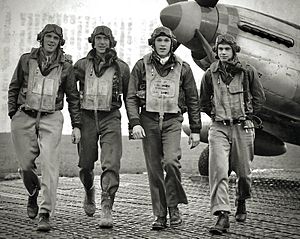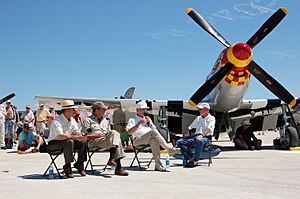Bud Anderson facts for kids
Quick facts for kids
Bud Anderson
|
|
|---|---|

Anderson in 1944
|
|
| Nickname(s) | Bud |
| Born | January 13, 1922 Oakland, California, U.S. |
| Died | May 17, 2024 (aged 102) Auburn, California, U.S. |
| Allegiance | United States |
| Service/ |
United States Army Air Forces United States Air Force |
| Years of service | 1942–1972 |
| Rank |
|
| Unit | 357th Fighter Group |
| Commands held | 69th Fighter-Bomber Squadron 18th Tactical Fighter Wing 355th Tactical Fighter Wing |
| Battles/wars | World War II Vietnam War |
| Awards | Legion of Merit (2) Distinguished Flying Cross (5) Bronze Star Medal Air Medal (16) |
| Spouse(s) |
Eleanor Cosby
(m. 1945; died 2015) |
| Children | 2 |
| Other work | Manager of the McDonnell Aircraft Company's Flight Test Facility at Edwards AFB (1972–1998) |
Clarence Emil "Bud" Anderson (born January 13, 1922 – died May 17, 2024) was an amazing pilot in the United States Air Force. He was known as a "triple ace" in World War II. This means he shot down 15 or more enemy planes. He was the top pilot in his P-51 Mustang squadron during the war.
Bud Anderson flew many missions in Europe in 1944. He became a major at just 22 years old. After the war, he became a test pilot, flying new types of aircraft. He also led fighter squadrons and wings. He even served in the Vietnam War.
Anderson retired as a full colonel in 1972. Then, he worked for McDonnell Douglas, helping with flight tests. He is a member of the National Aviation Hall of Fame. He kept sharing his stories at events even when he was in his 90s. In 2022, he was given an honorary promotion to brigadier general.
Contents
Early life
Bud Anderson was born in Oakland, California. He grew up on a farm near Newcastle, California. He went to Placer Union High School in Auburn, California. In high school, he enjoyed playing football and basketball. He first became interested in flying at the Oakland Municipal Airport. When the Japanese attacked Pearl Harbor on December 7, 1941, he was working at the Sacramento Air Depot.
Military career
In January 1942, soon after the attack on Pearl Harbor, Anderson joined the United States Army. He wanted to become a pilot. He trained at Lindbergh Field in San Diego and Luke Field in Arizona. In September 1942, he earned his pilot wings. He became a second lieutenant in the United States Army Air Forces.
Anderson started flying Bell P-39 Airacobra planes. He flew with the 329th Fighter Squadron. Later, he joined the 363rd Fighter Squadron of the 357th Fighter Group. This group moved to different bases in California and Wyoming. In November 1943, they went to England.
World War II
The 357th Fighter Group was based at RAF Leiston in England. In January 1944, they received new North American P-51 Mustang planes. Anderson flew his first mission on February 5. On March 3, he shot down a German Messerschmitt Bf 109 plane. This was his first victory in the air.
On April 11, he shot down another Bf 109. On the same mission, he and two other pilots shared a victory. They shot down a Heinkel He 111 bomber. Anderson kept winning air battles. On May 12, he shot down a Bf 109 over Frankfurt. This was his fifth victory, making him a "flying ace." By the end of May, he had destroyed three more enemy aircraft.
On June 29, Anderson led his squadron to protect bombers over Leipzig. They met eight German Focke-Wulf Fw 190 planes. Anderson shot down three of them in a dogfight. In July, after his twelfth victory, he went home to the United States for a break.
Anderson returned to the 357th Fighter Group that fall. On November 27, he shot down two Fw 190s over Magdeburg. He also forced another to crash. On December 5, he led a mission over Berlin. His group was attacked by 20 Fw 190s. He shot down two more, which were his last victories.
Anderson flew 116 missions against the German Luftwaffe in Europe. He was the third-highest scoring ace in his group. He had 16 and a quarter aerial victories. His P-51 Mustang planes, both named Old Crow, were never hit by enemy fire. He never had to turn back from a mission. The 357th group was also known as the Yoxford Boys.
After the war
Anderson came back to the U.S. in January 1945. He worked as a recruiter in Ohio. From 1948 to 1953, he was a test pilot at Wright Field. He helped with the FICON project. This project tried to attach jet fighters to a bomber's wingtips. The idea was to help fighters fly further and carry their own protection.
Anderson went to college for military leaders from 1954 to 1955. Then he worked in South Korea. He led the 69th Fighter-Bomber Squadron there.
He continued as a test pilot at Edwards Air Force Base. He was in charge of flight test operations from 1957 to 1962. He then went to another military college. From 1965 to 1967, he was stationed in Okinawa. He helped lead the 18th Tactical Fighter Wing.
After working at the Air Force headquarters, Anderson led the 355th Tactical Fighter Wing. This was during the final months of the Vietnam War, from June to December 1970. He flew missions against enemy supply lines. He also helped close the base when his unit was no longer active.
Anderson retired as a colonel in March 1972. He received 25 awards for his service. He flew over 100 types of aircraft and spent over 7,000 hours in the air. He was a close friend of Brigadier General Chuck Yeager. They both served in the 357th Fighter Group during World War II.
Personal life and death

Bud Anderson married Eleanor Cosby on February 23, 1945. She passed away on January 30, 2015, in Auburn, California. They had two children together.
After retiring from the Air Force, Anderson managed the Flight Test Facility at Edwards Air Force Base. He worked there until 1998. In 1990, he helped write a book about his life called To Fly & Fight—Memoirs of a Triple Ace.
On July 19, 2008, Anderson was honored. He was added to the National Aviation Hall of Fame. In 2013, he joined the International Air & Space Hall of Fame. A life-size bronze statue of him was placed at the Auburn Municipal Airport.
Anderson turned 100 years old in January 2022. His hometown of Auburn celebrated him with a big party. He was the last living American triple flying ace from World War II. On December 2, he was given an honorary promotion to brigadier general. This was done by General Charles Q. Brown Jr., the Air Force chief of staff.
Bud Anderson passed away peacefully in his sleep on May 17, 2024. He was 102 years old and was at his home in Auburn, California.
Aerial victory credits
| Date | # | Type | Location | Aircraft flown | Unit Assigned |
|---|---|---|---|---|---|
| March 8, 1944 | 1 | Messerschmitt Bf 109 | Hanover, Germany | P-51B | 363 FS, 357 FG |
| April 11, 1944 | 1 | Bf 109 | Hanover, Germany | P-51B | 363 FS, 357 FG |
| April 11, 1944 | 0.20 | Heinkel He 111 | Hanover, Germany | P-51B | 363 FS, 357 FG |
| April 30, 1944 | 1 | Focke-Wulf Fw 190 | Orléans, France | P-51B | 363 FS, 357 FG |
| May 8, 1944 | 1 | Fw 190 | Soltau, Germany | P-51B | 363 FS, 357 FG |
| May 12, 1944 | 1 | Bf 109 | Frankfurt, Germany | P-51B | 363 FS, 357 FG |
| May 27, 1944 | 2 | Bf 109 | Strasbourg, France | P-51B | 363 FS, 357 FG |
| May 30, 1944 | 1 | Bf 109 | Schönebeck, Germany | P-51B | 363 FS, 357 FG |
| June 29, 1944 | 3 | Fw 190 | Leipzig, Germany | P-51B | 363 FS, 357 FG |
| July 7, 1944 | 1 | Bf 109 | Leipzig, Germany | P-51B | 363 FS, 357 FG |
| November 27, 1944 | 2 | Fw 190 | Magdeburg, Germany | P-51D | 363 FS, 357 FG |
| December 5, 1944 | 2 | Fw 190 | Berlin, Germany | P-51D | 363 FS, 357 FG |
-
-
-
- SOURCES: Air Force Historical Study 85: USAF Credits for the Destruction of Enemy Aircraft, World War II
-
-
Awards
Anderson received 25 awards for his brave service. Some of them include:
| Legion of Merit with one bronze oak leaf cluster | |
| Distinguished Flying Cross with four bronze oak leaf clusters | |
| Bronze Star Medal | |
| Air Medal with three silver oak leaf clusters | |
| Air Force Commendation Medal | |
| Air Force Presidential Unit Citation | |
| Air Force Outstanding Unit Award | |
| American Campaign Medal | |
| European-African-Middle Eastern Campaign Medal with four bronze service stars | |
| World War II Victory Medal | |
| National Defense Service Medal with one bronze service star | |
| Vietnam Service Medal with two bronze service stars | |
| Korea Defense Service Medal | |
| Air Force Longevity Service Award with one silver and one bronze oak leaf clusters | |
| Small Arms Expert Marksmanship Ribbon | |
| Legion of Honour (France) | |
| Croix de Guerre, with silver star (France) | |
| Republic of Vietnam Gallantry Cross | |
| Vietnam Campaign Medal |
- American Fighter Aces Association life member
- Fellow, Society of Experimental Test Pilots
- Aerospace Walk of Honor, 1993
- Crystal Eagle Award, 2011
- Congressional Gold Medal, May 2015






